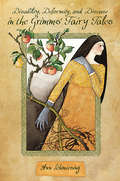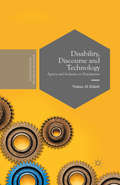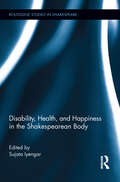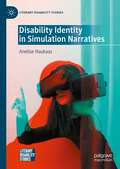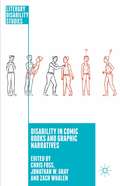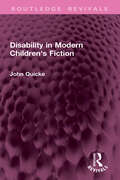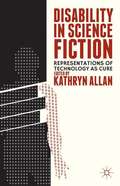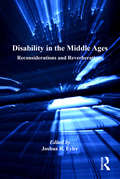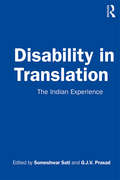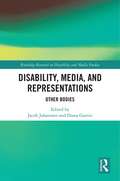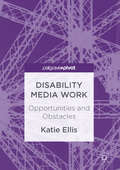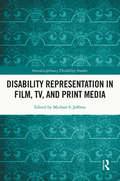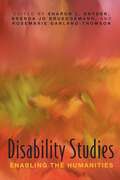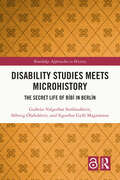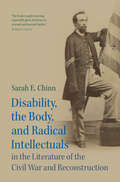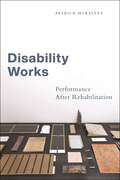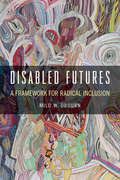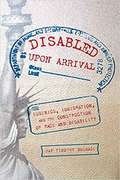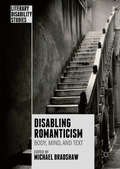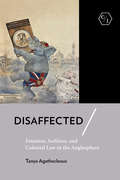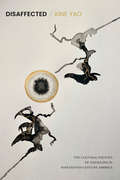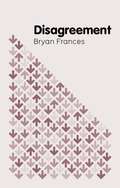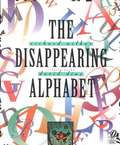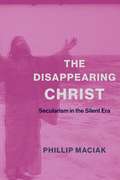- Table View
- List View
Disability, Deformity, and Disease in the Grimms' Fairy Tales
by Ann SchmiesingAlthough dozens of disabled characters appear in the Grimms' Children's and Household Tales, the issue of disability in their collection has remained largely unexplored by scholars. In Disability, Deformity, and Disease in the Grimms' Fairy Tales, author Ann Schmiesing analyzes various representations of disability in the tales and also shows how the Grimms' editing (or "prostheticizing") of their tales over seven editions significantly influenced portrayals of disability and related manifestations of physical difference, both in many individual tales and in the collection overall. Schmiesing begins by exploring instabilities in the Grimms' conception of the fairy tale as a healthy and robust genre that has nevertheless been damaged and needs to be restored to its organic state. In chapter 2, she extends this argument by examining tales such as "The Three Army Surgeons" and "Brother Lustig" that problematize, against the backdrop of war, characters' efforts to restore wholeness to the impaired or diseased body. She goes on in chapter 3 to study the gendering of disability in the Grimms' tales with particular emphasis on the Grimms' editing of "The Maiden Without Hands" and "The Frog King or Iron Henry." In chapter 4, Schmiesing considers contradictions in portrayals of characters such as Hans My Hedgehog and the Donkey as both cripple and "supercripple"--a figure who miraculously "overcomes" his disability and triumphs despite social stigma. Schmiesing examines in chapter 5 tales in which no magical erasure of disability occurs, but in which protagonists are depicted figuratively "overcoming" disability by means of other personal abilities or traits. The Grimms described the fairy tale using metaphors of able-bodiedness and wholeness and espoused a Romantic view of their editorial process as organic restoration. Disability, Deformity, and Disease in the Grimms' Fairy Tales shows, however, the extent to which the Grimms' personal experience of disability and illness impacted the tales and reveals the many disability-related amendments that exist within them. Readers interested in fairy-tales studies and disability studies will appreciate this careful reading of the Grimms' tales.
Disability, Discourse and Technology: Agency and Inclusion in (Inter)action (Postdisciplinary Studies in Discourse)
by Najma Al ZidjalyExclusion is the main predicament faced by people with disabilities across contexts and cultures, yet it is one of the least academically studied concepts. This book offers an applied linguistics perspective on critical and timely issues in disability research, filling in a number of gaps in discourse analysis and disability studies.
Disability, Health, and Happiness in the Shakespearean Body (Routledge Studies in Shakespeare)
by Sujata IyengarThis book considers early modern and postmodern ideals of health, vigor, ability, beauty, well-being, and happiness, uncovering and historicizing the complex negotiations among physical embodiment, emotional response, and communally-sanctioned behavior in Shakespeare's literary and material world. The volume visits a series of questions about the history of the body and how early modern cultures understand physical ability or vigor, emotional competence or satisfaction, and joy or self-fulfillment. Individual essays investigate the purported disabilities of the "crook-back" King Richard III or the "corpulent" Falstaff, the conflicts between different health-care belief-systems in The Taming of the Shrew and Hamlet, the power of figurative language to delineate or even instigate puberty in the Sonnets or Romeo and Juliet, and the ways in which the powerful or moneyed mediate the access of the poor and injured to cure or even to care. Integrating insights from Disability Studies, Health Studies, and Happiness Studies, this book develops both a detailed literary-historical analysis and a provocative cultural argument about the emphasis we place on popular notions of fitness and contentment today.
Disability Identity in Simulation Narratives (Literary Disability Studies)
by Anelise HaukaasDisability Identity in Simulation Narratives considers the relationship between disability identity and simulation activities (ranging from traditional gameplay to more revolutionary technology) in contemporary science fiction. Anelise Haukaas applies posthumanist theory to an examination of disability identity in a variety of science fiction texts: adult novels, young adult literature and comics, as well as ethnographic research with gamers. Haukaas argues that instead of being a means of escapism, simulated experiences are a valuable tool for cultivating self-acceptance and promoting empathy. Through increasingly accessible technology and innovative gameplay, traditional hierarchies are dismantled, and different ways of being are both explored and validated. Ultimately, the book aims to expand our understandings of disability, performance, and self-creation in significant ways by exploring the boundless selves that the simulated environments in these texts allow.
Disability in Comic Books and Graphic Narratives (Literary Disability Studies)
by Zach WhalenAs there has yet to be any substantial scrutiny of the complex confluences a more sustained dialogue between disability studies and comics studies might suggest, Disability in Comic Books and Graphic Narratives aims through its broad range of approaches and focus points to explore this exciting subject in productive and provocative ways.
Disability in Modern Children's Fiction (Routledge Revivals)
by John QuickeFirst published in 1985, Disability in Modern Children’s Fiction presents a case for the inclusion of a planned element in the mainstream curriculum, specifically designed to encourage positive attitudes and actions towards children with special needs, and for utilising the possibilities inherent in fiction for helping all children to explore their thoughts and feelings in this area. The central chapters of the book are concerned with a critical examination of specific texts, focusing on how they deal with disability in a story context. Books are grouped for discussion under common themes which have been teased out according to their contemporary relevance: the effects on the family of a severely disabled child; the struggle of a child with a disability for personal identity in oppressive social circumstances; the interaction between disability, race, gender and social class; the different reactions of ‘normal’ children towards disabled peers; the failings of the medical approach to disability; love, sex, adolescence and disability; the relationship between children and handicapped adults. The penultimate chapter is concerned with an evaluation of picture books and quasi-fiction for younger children. This book will be of interest to students of disability studies, pedagogy and literature.
Disability in Science Fiction
by Kathryn AllanIn this groundbreaking collection, twelve international scholars - with backgrounds in disability studies, English and world literature, classics, and history - discuss the representation of dis/ability, medical "cures," technology, and the body in science fiction.
Disability in the Middle Ages: Reconsiderations and Reverberations
by Joshua R. EylerWhat do we mean when we talk about disability in the Middle Ages? This volume brings together dynamic scholars working on the subject in medieval literature and history, who use the latest approaches from the field to address this central question. Contributors discuss such standard medieval texts as the Arthurian Legend, The Canterbury Tales and Old Norse Sagas, providing an accessible entry point to the field of medieval disability studies to medievalists. The essays explore a wide variety of disabilities, including the more traditionally accepted classifications of blindness and deafness, as well as perceived disabilities such as madness, pregnancy and age. Adopting a ground-breaking new approach to the study of disability in the medieval period, this provocative book will interest medievalists and scholars of disability throughout history.
Disability in Translation: The Indian Experience
by Someshwar Sati G.J.V. PrasadThis volume explores how disability is seen, written about, read and understood through literature and translation. Foregrounding the asymmetrical world of power relations, it delves into the act of translation to exhibit how disability is constructed and deployed in language and culture. The essays in the volume reflect and theorise on experiences of translating various Indian-language stories (into English) which have disability as their subject. They focus on recovering and empowering marginal voices, as well as on the mechanics of translating idioms of disability. Furthermore, the book goes on to engage the reader to demonstrate how disability, and the space it occupies in our lives, can be reinforced or deconstructed in translation. A major intervention in translation and disability studies, this volume will be of great interest to scholars and researchers of literature, culture, and sociology.
Disability, Media, and Representations: Other Bodies (Routledge Research in Disability and Media Studies)
by Jacob Johanssen Diana GarrisiBringing together scholars from around the world to research the intersection between media and disability, this edited collection aims to offer an interdisciplinary exploration and critique of print, broadcast and online representations of physical and mental impairments.Drawing on a wide range of case studies addressing how people can be ‘othered’ in contemporary media, the chapters focus on analyses of hateful discourses about disability on Reddit, news coverage of disability and education, media access of individuals with disabilities, the logic of memes and brain tumour on Twitter, celebrity and Down Syndrome on Instagram, disability in TV drama, the metaphor of disability for the nation; as well as an autoethnography of treatment of breast cancer. Providing a much-needed global perspective, Disability, Media, and Representations examines the relationship between self-representation and representations in either reinforcing or debunking myths around disability, and ways in which academic discourse can be differently articulated to study the relationship between media and disability. This book will be of interest to students and researchers of disability studies and media studies as well as activists and readers engaged in debates on diversity, inclusivity and the media.
Disability Media Work
by Katie EllisThis book interrogates trends in training and employment of people with disabilities in the media through an analysis of people with disabilities' self-representation in media employment. Improving disability representations in the media is vital to improving the social position of people with disability, and including people with lived experience of disability is integral to this process. While the media industry has changed significantly as a result of digital and participatory media, discriminatory attitudes around fear and pity continue to impact whether people with disability find work in the media. The book demonstrates no significant changes in attitudes towards employing disabled media workers since the 1990s when the last major research into this topic took place. By focusing on the employment of people with disability in media industries, Katie Ellis addresses a neglected area of media diversity, appealing to researchers in media and cultural studies as well as critical disability studies.
Disability Representation in Film, TV, and Print Media (Interdisciplinary Disability Studies)
by Michael S. JeffressUsing sources from a wide variety of print and digital media, this book discusses the need for ample and healthy portrayals of disability and neurodiversity in the media, as the primary way that most people learn about conditions. It contains 13 newly written chapters drawing on representations of disability in popular culture from film, television, and print media in both the Global North and the Global South, including the United States, Canada, India, and Kenya. Although disability is often framed using a limited range of stereotypical tropes such as victims, supercrips, or suffering patients, this book shows how disability and neurodiversity are making their way into more mainstream media productions and publications with movies, television shows, and books featuring prominent and even lead characters with disabilities or neurodiversity. Disability Representation in Film, TV, and Print Media will be of interest to all scholars and students of disability studies, cultural studies, film studies, gender studies, and sociology more broadly.
Disability Studies: Enabling the Humanities
by Sharon L. Snyder Brenda Jo Brueggemann Rosemarie Garland-ThomsonImages of disability pervade language and literature, yet disability is, as the volume's introduction notes, "the ubiquitous unspoken topic in contemporary culture." The twenty-five essays in Disability Studies provide perspectives on disabled people and on disability in the humanities, art, the media, medicine, psychology, the academy, and society.Edited and introduced by Sharon L. Snyder, Brenda Jo Brueggemann, and Rosemarie Garland-Thomson and containing an afterword by Michael Bérubé (author of Life As We Know It), the volume is rich in its cast of characters (including John Bulwer, Teresa de Cartagena, Audre Lorde, Oliver Sacks, Samuel Johnson, Mark Twain, Walt Whitman); in its powerful, authentic accounts of disabled conditions (deafness, blindness, MS, cancer, the absence of limbs); in its different settings (ancient Greece, medieval Spain, Nazi Germany, the modern United States); and in its mix of the intellectual and the emotional, of subtle theory and plainspoken autobiography.
Disability Studies Meets Microhistory: The Secret Life of Bíbí in Berlín (ISSN)
by Sigurður Gylfi Magnússon Guðrún Valgerður Stefánsdóttir Sólveig ÓlafsdóttirThis volume explores the life of Bjargey “Bíbí” Kristjánsdóttir (1927–1999), an Icelandic woman with intellectual disabilities, through analysis of her autobiography and personal archive on the basis of the research disciplines of critical disability studies and microhistory.Bíbí, who grew up in northern Iceland on a small farm called Berlin, fell ill when she was in her first year and was afterward labeled "feeble-minded" by her family and the local community. When Bíbí died, she had finished a 145,000-word autobiography which she had written alone and kept secret from her family and neighbors, very few of whom even knew that she could read and write. This book aims to consider Bíbí’s life through her autobiography and other historical sources she created, to identify how various historical, social, and cultural factors interacted and influenced her circumstances. It explores Bíbí’s agency, and how she managed to play her cards within the narrow scope given to her by society. What makes Bíbí’s history extraordinary is precisely the direct connection to her world through her counter-archive.This book provides students and scholars of the humanities and the social sciences with a new way of critical thinking about both disciplines.
Disability, the Body, and Radical Intellectuals in the Literature of the Civil War and Reconstruction (Cambridge Studies in American Literature and Culture)
by Sarah E. ChinnDuring the Civil War, hundreds of thousands of men were injured, and underwent amputation of hands, feet, limbs, fingers, and toes. As the war drew to a close, their disabled bodies came to represent the future of a nation that had been torn apart, and how it would be put back together again. In her authoritative and engagingly written new book, Sarah Chinn claims that amputation spoke both corporeally and metaphorically to radical white writers, ministers, and politicians about the need to attend to the losses of the Civil War by undertaking a real and actual Reconstruction that would make African Americans not just legal citizens but actual citizens of the United States. She traces this history, reviving little-known figures in the struggle for Black equality, and in so doing connecting the racial politics of 150 years ago with contemporary debates about justice and equity.
Disability Works: Performance After Rehabilitation (Performance and American Cultures #8)
by Patrick McKelveyA cultural history of disability, performance, and work in the modern United StatesIn 1967, the US government funded the National Theatre of the Deaf, a groundbreaking rehabilitation initiative employing deaf actors. This project aligned with the postwar belief that transforming bodies, minds, aesthetics, and institutions could liberate disabled Americans from economic reliance on the state, and demonstrated the growing optimism that performance could provide job opportunities for people with disabilities.Disability Works offers an original cultural history of disability and performance in modern America, exploring rehabilitation’s competing legacies. The book highlights an unexpected alliance of rehabilitation professionals, deaf teachers, policy makers, disability activists, queer artists, and religious leaders who championed performance’s rehabilitative potential. At the same time, some disabled artists imagined a different political itinerary for theatrical practice. Rather than acquiescing to the terms of productive citizenship, these artists recuperated rehabilitation as a creative resource for imagining and building a world beyond work. Using previously unexplored archives, Disability Works portrays the history of disabled Americans’ performance labor as both a national aspiration and a national problem. The book reveals how disabled artists and activists ingeniously used rehabilitative resources to fuel their performance practices, breaking free from the grasp of rehabilitation and fostering more just institutions.From state-funded “sign-mime” to Black modern dance, community theatre to Stanislavskian actor training, speculative activism to epistolary performance, Disability Works recovers an expansive repertoire of aesthetic and infrastructural investigations into the terms of how disability works in modern American culture.
Disabled Futures: A Framework for Radical Inclusion (D/C: Dis/color #3)
by Milo W. ObournDisabled Futures makes an important intervention in disability studies by taking an intersectional approach to race, gender, and disability. Milo Obourn reads disability studies, gender and sexuality studies, and critical race studies to develop a framework for addressing inequity. They theorize the concept of “racialized disgender”—to describe the ways in which racialization and gendering are social processes with disabling effects—thereby offering a new avenue for understanding race, gender, and disability as mutually constitutive. Obourn uses readings of literature and popular culture from Lost and Avatar to Octavia Butler’s Xenogenesis trilogy to explore and unpack specific ways that race and gender construct—and are constructed by—historical notions of ability and disability, sickness and health, and successful recovery versus damaged lives. What emerges is not only a more complex and deeper understanding of the intersections between ableism, racism, and (cis)sexism, but also possibilities for imagining alternate and more radically inclusive futures in which all of our identities, experiences, freedoms, and oppressions are understood as interdependent and intertwined.
Disabled Upon Arrival: Eugenics, Immigration, And The Construction Of Race And Disability
by Jay Timothy DolmageIn North America, immigration has never been about immigration. That was true in the early twentieth century when anti-immigrant rhetoric led to draconian crackdowns on the movement of bodies, and it is true today as new measures seek to construct migrants as dangerous and undesirable. This premise forms the crux of Jay Timothy Dolmage’s new book Disabled Upon Arrival: Eugenics, Immigration, and the Construction of Race and Disability, a compelling examination of the spaces, technologies, and discourses of immigration restriction during the peak period of North American immigration in the early twentieth century. Through careful archival research and consideration of the larger ideologies of racialization and xenophobia, Disabled Upon Arrival links anti-immigration rhetoric to eugenics—the flawed “science” of controlling human population based on racist and ableist ideas about bodily values. Dolmage casts an enlightening perspective on immigration restriction, showing how eugenic ideas about the value of bodies have never really gone away and revealing how such ideas and attitudes continue to cast groups and individuals as disabled upon arrival.
Disabling Romanticism
by Michael BradshawThis book investigates the presence of disability in British Romantic literature, as subject matter, as metaphorical theme, and as lived experience. It is the first collection of its kind, breaking new ground in re-interpreting key texts and providing a challenging overview of this emerging field. The collection offers both a critique of academic Romantic studies and an affirmation of the responsiveness of the Romantic canon to new stimuli. Authors discussed include William Blake, Lord Byron, Ann Batten Cristall, Samuel Taylor Coleridge, George Darley, Richard Payne Knight, William Gilpin, Mary Robinson, Mary Shelley, Robert Southey, and William Wordsworth.
Disabling Romanticism (Literary Disability Studies)
by Michael BradshawThis book investigates the presence of disability in British Romantic literature, as subject matter, as metaphorical theme, and as lived experience. It is the first collection of its kind, breaking new ground in re-interpreting key texts and providing a challenging overview of this emerging field. The collection offers both a critique of academic Romantic studies and an affirmation of the responsiveness of the Romantic canon to new stimuli. Authors discussed include William Blake, Lord Byron, Ann Batten Cristall, Samuel Taylor Coleridge, George Darley, Richard Payne Knight, William Gilpin, Mary Robinson, Mary Shelley, Robert Southey, and William Wordsworth.
Disaffected: Emotion, Sedition, and Colonial Law in the Anglosphere (Corpus Juris: The Humanities in Politics and Law)
by Tanya AgathocleousDisaffected examines the effects of antisedition law on the overlapping public spheres of India and Britain under empire. After 1857, the British government began censoring the press in India, culminating in 1870 with the passage of Section 124a, a law that used the term "disaffection" to target the emotional tenor of writing deemed threatening to imperial rule. As a result, Tanya Agathocleous shows, Indian journalists adopted modes of writing that appeared to mimic properly British styles of prose even as they wrote against empire. Agathocleous argues that Section 124a, which is still used to quell political dissent in present-day India, both irrevocably shaped conversations and critiques in the colonial public sphere and continues to influence anticolonialism and postcolonial relationships between the state and the public. Disaffected draws out the coercive and emotional subtexts of law, literature, and cultural relationships, demonstrating how the criminalization of political alienation and dissent has shaped literary form and the political imagination.
Disaffected: The Cultural Politics of Unfeeling in Nineteenth-Century America (Perverse Modernities: A Series Edited by Jack Halberstam and Lisa Lowe)
by Xine YaoIn Disaffected Xine Yao explores the racial and sexual politics of unfeeling—affects that are not recognized as feeling—as a means of survival and refusal in nineteenth-century America. She positions unfeeling beyond sentimentalism's paradigm of universal feeling. Yao traces how works by Herman Melville, Martin R. Delany, Elizabeth Stuart Phelps, Frances Ellen Watkins Harper, and Sui Sin Far engaged major sociopolitical issues in ways that resisted the weaponization of white sentimentalism against the lives of people of color. Exploring variously pathologized, racialized, queer, and gendered affective modes like unsympathetic Blackness, queer female frigidity, and Oriental inscrutability, these authors departed from the values that undergird the politics of recognition and the liberal project of inclusion. By theorizing feeling otherwise as an antisocial affect, form of dissent, and mode of care, Yao suggests that unfeeling can serve as a contemporary political strategy for people of color to survive in the face of continuing racism and white fragility.Duke University Press Scholars of Color First Book Award recipient
Disagreement (Key Concepts In Philosophy)
by Bryan FrancesRegardless of who you are or how you live your life, you disagree with millions of people on an enormous number of topics from politics, religion and morality to sport, culture and art. Unless you are delusional, you are aware that a great many of the people who disagree with you are just as smart and thoughtful as you are - in fact, you know that often they are smarter and more informed. But believing someone to be cleverer or more knowledgeable about a particular topic usually won’t change your mind. Should it? This book is devoted to exploring this quandary - what should we do when we encounter disagreement, particularly when we believe someone is more of an authority on a subject than we are? The question is of enormous importance, both in the public arena and in our personal lives. Disagreement over marriages, beliefs, friendships and more causes immense personal strife. People with political power disagree about how to spend enormous amounts of money, about what laws to pass, or about wars to fight. If only we were better able to resolve our disagreements, we would probably save millions of lives and prevent millions of others from living in poverty. The first full-length text-book on this philosophical topic, Disagreement provides students with the tools they need to understand the burgeoning academic literature and its (often conflicting) perspectives. Including case studies, sample questions and chapter summaries, this engaging and accessible book is the perfect starting point for students and anyone interested in thinking about the possibilities and problems of this fundamental philosophical debate.
The Disappearing Alphabet
by Richard WilburPulitzer Prize-winning poet Richard Wilbur turns his sharp eye to the noble alphabet and imagines what life would be like without these twenty-six little--but powerful--letters. Packed with humor and witty subtleties, the verse in this captivating picture book is splendidly matched by Caldecott Medal winner David Diaz's hilariously clever illustrations.
The Disappearing Christ: Secularism in the Silent Era
by Phil MaciakAt the turn of the twentieth century, American popular culture was booming with opportunities to see Jesus Christ. From the modernized eyewitness gospel of Ben-Hur to the widely circulated passion play films of Edison, Lumière, and Pathé; from D. W. Griffith’s conjuration of a spectral white savior in Birth of a Nation to W. E. B. Du Bois’s “Black Christ” story cycle, Jesus was constantly and inventively visualized across media, and especially in the new medium of film. Why, in an era traditionally defined by the triumph of secular ideologies and institutions, were so many artists rushing to film Christ’s miracles and use his story and image to contextualize their experiences of modernity?In The Disappearing Christ, Phillip Maciak examines filmic depictions of Jesus to argue that cinema developed as a model technology of secularism, training viewers for belief in a secular age. Negotiating between the magic trick and the documentary image, the conflicting impulses of faith and skepticism, the emerging aesthetic of film in this period visualized the fraught process of secularization. Cinematic depictions of an appearing and disappearing Christ became a powerful vehicle for Americans to navigate a rapidly modernizing society. Studying these films alongside a multimedia, interdisciplinary archive of novels, photographs, illustrations, and works of theology, travel writing, and historiography, The Disappearing Christ offers a new narrative of American cultural history at the intersection of cinema studies and religious studies.
